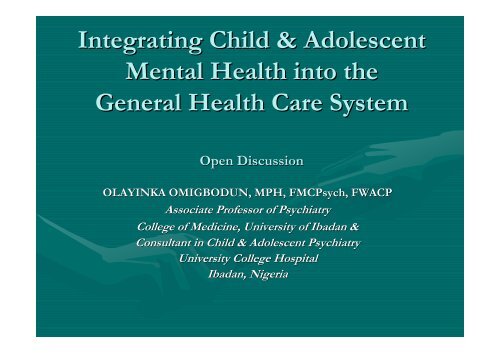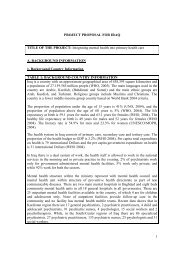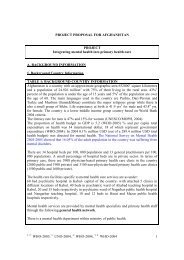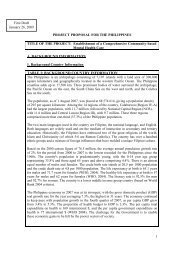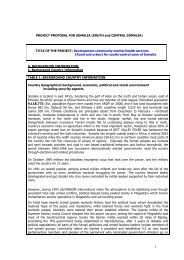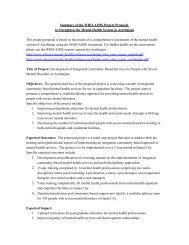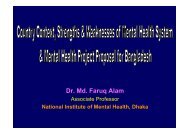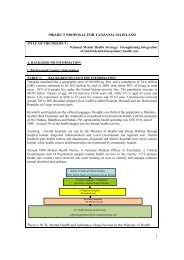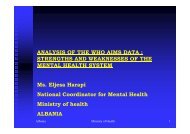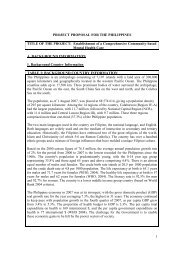Integrating Child & Adolescent Mental Health into the ... - Cittadinanza
Integrating Child & Adolescent Mental Health into the ... - Cittadinanza
Integrating Child & Adolescent Mental Health into the ... - Cittadinanza
- No tags were found...
You also want an ePaper? Increase the reach of your titles
YUMPU automatically turns print PDFs into web optimized ePapers that Google loves.
<strong>Integrating</strong> <strong>Child</strong> & <strong>Adolescent</strong><strong>Mental</strong> <strong>Health</strong> <strong>into</strong> <strong>the</strong>General <strong>Health</strong> Care SystemOpen DiscussionOLAYINKA OMIGBODUN, MPH, FMCPsych, FWACPAssociate Professor of PsychiatryCollege of Medicine, University of Ibadan &Consultant in <strong>Child</strong> & <strong>Adolescent</strong> PsychiatryUniversity College HospitalIbadan, Nigeria
Conversation with a NeurosurgeonColleague & Management Executive of aTeaching Hospital• “Dr. Omigbodun where are you coming from?” my colleagueasked.• “I I have just finished running <strong>the</strong> child psychiatric clinic”, , I repliedhoping to hear a well done and happy for an opportunityto ask for more staff and help.• “Honestly any child who needs to see you must need deliverance fromdemons” was <strong>the</strong> ‘commendation’ I got from a fellowcolleague in <strong>the</strong> neurosciences.
WHAT TACTICS ARE NEEDED?Tie up stringsLinkagePhysical<strong>Health</strong>Care<strong>Mental</strong><strong>Health</strong>Untie stringsStigmaDivision
OBJECTIVES1. Define key words2. Describe <strong>the</strong> prevalence & pattern of child mentalhealth problems at different settings of care in LowIncome Countries:– Community– Primary Care– Especially Difficult Situations
POSSIBLE ISSUES FOR DISCUSSION1. Related psychosocial issues of children in <strong>the</strong>sesettings of care2. Appraise and analyse problems with available CAMHservices and difficulties with integration3. Conflicts in legislation pertaining to <strong>Child</strong> <strong>Mental</strong><strong>Health</strong>4. Examples of models/integrated care5. Proffer solutions to providing a coordinated CAMHservice in <strong>the</strong> general health care system
KEY WORDS• Integrate• <strong>Child</strong> & <strong>Adolescent</strong>• <strong>Mental</strong> <strong>Health</strong>• General <strong>Health</strong> Care
CHILD & ADOLESCENT<strong>Child</strong>: up to 17 years<strong>Adolescent</strong>: 10 to 19years
<strong>Mental</strong> <strong>Health</strong>• <strong>Health</strong> according to WHO• <strong>Health</strong> is a state of complete physical, mentaland social well being and not merely <strong>the</strong> absenceof disease or infirmity• <strong>Health</strong> is more than <strong>the</strong> absence of disease• This can now be applied to mental health
<strong>Mental</strong> <strong>Health</strong>• Optimal development & use of mental abilities(thinking, reasoning, understanding, feeling,behaviour)• Successful performance of mental functions interms of thought, mood & behaviour• Results in productive activities, fulfillingrelationships, ability to adapt to change & copewith adversity• <strong>Mental</strong> health is positive & everyone needs itSadock and Sadock, 2007
<strong>Mental</strong> Illness or Disorders• Illnesses with psychological or behaviouralmanifestations• Abnormalities• Emotions• Thoughts• Cognitive functions• Sensory perceptions• Beliefs• Behaviour
Defining <strong>Child</strong> &<strong>Adolescent</strong> <strong>Mental</strong><strong>Health</strong><strong>Child</strong> and adolescent mental health include <strong>the</strong>following (WHO, 2005):• A sense of identity and self worth• Sound family and peer relationships• An ability to be productive and to learn• Capacity to use developmental challenges andcultural resources to maximise development
Defining <strong>Child</strong> &<strong>Adolescent</strong> <strong>Mental</strong><strong>Health</strong><strong>Mental</strong> health in childhood is needed for:• Optimal psychological development• Productive social relationships• Effective learning• An ability to care for self• Good physical health• Effective economic participation as adults
Every <strong>Child</strong> Needs <strong>Mental</strong> <strong>Health</strong>• Promotion of mental health• Prevention of mental illness• Treatment of mental illness• Rehabilitation of <strong>the</strong> mentally ill
General <strong>Health</strong> Care• Service providing holistic care• Comprehensive continuous form of care• Bio-psychopsycho-social social model of disease• Depending on <strong>the</strong> service arrangement– Primary or secondary care– Different cadres of staff depending on country ®ion– PHC (public & private)– School health– District hospitals
NigeriaTiers of <strong>Health</strong>care Delivery ServiceTertiary <strong>Health</strong>care (Psychiatrists)(Teaching & Specialist Hospitals)Federal GovernmentSecondary <strong>Health</strong>careDistrict Hospitals (Paediatricians)State Governments<strong>Health</strong> Care (PHC) (Nurses, Community <strong>Health</strong>Officers) DistrictsWho will link up services in <strong>the</strong>se levels of care?Who will link up services in <strong>the</strong>se levels of care?FMOH, 1996
<strong>Child</strong> Psychiatric Service in <strong>the</strong> UK(Department Of <strong>Health</strong> , 2004)CAMHS FrameworkTier 4: Essential tertiary level services such as day units, highlyhlyspecialised out-patient teams and in-patient units.Tier 3: A specialised multi-disciplinary service formore severe, complex or persistent disordersTier 2: A level of service provided by uni-professionalgroups which relate to each o<strong>the</strong>r through a network ra<strong>the</strong>rthan a team (Primary mental health workers)Tier 1: A primary level of care (Teachers, health visitors, generalpractitioners, social workers, voluntary workers)
• How do we view child and adolescentmental health?– Positive– Negative– Problems– Disorders– For all children & adolescents
• What are our views & perspectives onGeneral <strong>Health</strong> Care?– Primary level– Secondary level– Varied levels
Why Integrate CAMH in General<strong>Health</strong> Care system• Declining mortality in resource poor settings• Largely youthful populations• <strong>Child</strong> rights• General health workers see most children withmental health disorders• Large proportions of our population live in verydifficult circumstances
Large Young Population
PROPORTIONS OF THE POPULACE LESSTHAN 15YEARS IN SELECTED AFRICANCOUNTRIES
Country/Region<strong>Mental</strong> <strong>Health</strong> Professionals OverburdenedPopulation(Millions)PsychiatristsEthiopia 72 17 none<strong>Child</strong>PsychiatristsServicesnoneKenya 32.8 45 4 LimitedNigeria 150 150 5 LimitedSA:Nor<strong>the</strong>rnCape &Limpopo6 5 nonenoneTunisia 10 200 15 PresentUgandan 27 27 4 Limited
Magnitude of <strong>Child</strong> <strong>Mental</strong><strong>Health</strong> Problems• Dearth of Large Scale Studies• Used broad groupings
Community StudiesKhartoum, Sudan197 children aged 3-153years from Villagesaround Khartoum, SudanCederblad, 1968
Community StudiesKhartoum, Sudan
Community StudiesIbadan, Nigeria16% of 440 children aged 5-16years 5had severebehaviour disordersJegede & Cederblad, 1990
Community StudiesChinaCommunity Studies of children in China reveal rates of mentalhealth problems averaging about 13%. (Hong et al, 2004)
Community StudiesCalicut District, South India9% of 1403 children aged 8-12years 8in Calicut districtof South India had mental disorders(Hacket et al, 1999)
School StudySao Paulo, BrazilSchool children in Sao Paulo and surrounding ruralareas revealed that 13% had psychiatric disorders(Rohde et al, 2004)
School StudyRural & Urban Southwest Nigeria1 in 5 school going adolescents had suicidal ideationin <strong>the</strong> previous year and 1 in 10 had attempted suicide.Sexual abuse and exposure to violence were main riskfactors (Omigbodun et al, 2008)
Primary CareIndia, Sudan, Philippines, ColumbiaBetween 12% to 29% of children attending PC werefound to have mental disorders (Giel et al, 1981)
Primary CareGuinea BissauDe Jong, 1989
Primary CareIbadan, Nigeria990 children aged 7-147years jointly interviewed withmo<strong>the</strong>rs using DSM111R criteria. One fifth had specificDSMIIR diagnosis (Gureje, Omigbodun, 1994)
Primary CareIbadan, Nigeria
<strong>Child</strong>ren in Especially Difficult Circumstances(CEDC)• Three principal & distinct types(UNICEF, 2005)Street <strong>Child</strong>ren
<strong>Child</strong>ren in Especially Difficult Circumstances(CEDC)? Route to a life on <strong>the</strong> Street?Street childrenBreak links with <strong>the</strong>ir familiesAbandon formal educationStreets to hawk various waresSheer poverty in familiesShift of rural poor to urban areas`
Who are <strong>the</strong>se Street <strong>Child</strong>ren? 13.3%Aged 8 – 18 yearsMale96.7%Female•70% Living on street over 2 years•45% Use Psychoactive Substances•69% Use Alcohol•24% Drug Courier•11% Raped•50% Sex Work
Who are <strong>the</strong>se Street <strong>Child</strong>ren? 2School Problems of Street <strong>Child</strong>ren50%40%46%47%30%27%20%10%0%Refusal Suspension TruancySchooling Status
<strong>Child</strong>ren in Especially Difficult Circumstances(CEDC)Working <strong>Child</strong>ren
<strong>Child</strong>ren in Especially Difficult Circumstances(CEDC)<strong>Child</strong>ren in Institutions
Remand Home 2007 235 children (23 boys 12 girls)88%Criminal codeCare, Protection &abandonedBeyond parentalcontrol3%9%(Omigbodun & Bella, 2007)
Remand Home 2007 4Diagnostic Categories18%17%17%16%14%12%14% 14%11%10%8%6%4%3%6%2%0%ConductdisorderPsychoticillness<strong>Mental</strong>retardationCannabisabuseDepressivedisorderEnuresisEpilepsy(Omigbodun & Bella, , 2007)
<strong>Child</strong>ren in conflict regionsNor<strong>the</strong>rn Uganda, Gulu districtRates of psychiatric disorder (Okello,2007)
<strong>Child</strong> <strong>Mental</strong> <strong>Health</strong> Services UnavailableEnormous Toll ofHuman Suffering<strong>Child</strong> <strong>Mental</strong><strong>Health</strong>ReceivesLow Priorityfrom PolicyMakers<strong>Child</strong><strong>Mental</strong><strong>Health</strong>PolicyUnavailable<strong>Child</strong> <strong>Mental</strong>IllnessUndetected &Untreated inGeneral<strong>Health</strong>FacilitiesCommunityFocus onTraditional& ReligiousCare
<strong>Integrating</strong> CAMH <strong>into</strong> <strong>the</strong>General <strong>Health</strong> SystemEnhancementScopeLinkage<strong>Child</strong>Rights<strong>Child</strong>RearingTrainingPovertyCAMHPolicyPartnerships
THANK YOU
REFERENCES1. Abiodun, O. A. (1992) Emotional illness in a paediatric population on in Nigeria. East African Medical Journal. 69, 557-5592. Anbesse B (2008) Personal communication3. Bella T. T., Ogun O., (2007) Country Profile: Nigeria. Presented at IACAPAP Study Group (16 – 20 March 2007),Nairobi, Kenya4. De Jong, J.T (1989) A descent <strong>into</strong> African psychiatry. Transcultural ural Psychiatry, 26, 132-1361365. Dogra N, Omigbodun O., (2004) Learning from low-income countries. What are <strong>the</strong> lessons? Partnerships in mentalhealth care are possible without multidisciplinary teams. British h Medical Journal, 329, 1184-118511856. Federal Ministry of <strong>Health</strong> (1996) <strong>Health</strong> in Nigeria 1994/1995 Abuja: Federal Ministry of <strong>Health</strong>, National <strong>Health</strong>Management Information System7. Gaddour N., (2007) <strong>Child</strong> and adolescent mental health Profile in Tunisia. Presented at IACAPAP Study Group (16 –20 March 2007), Nairobi, Kenya8. Gaddour N, Benhaj Mbarek N, Bouguerra S, Naffati J, Gaha L (2008) ) Creation of an information booklet on autismfor parents and decision makers. Paper presented at <strong>the</strong> 18 th World Congress of <strong>the</strong> International Association for <strong>Child</strong>and <strong>Adolescent</strong> Psychiatry and Allied Professions, April 30 to May y 3, 2008, Istanbul, Turkey9. Gureje, O., Omigbodun, O.O., Gater, R.A., Ikuesan, B.A.,Morris J. (1994) Psychiatric disorders in a Paediatric PrimaryCare Clinic. British Journal of Psychiatry, 165, 527-53053010. Hong, K. M. (2005) <strong>Mental</strong> health care for children and adolescents: a regional perspective. World Psychiatry, 4, 15811. Jegede, O., Cederblad, M. (1990) Problemes de Saute <strong>Mental</strong>e des Enfants du Nigeria. Livre Annual de L’AssociationLInternationale de Psychiatrie de L’Enfant Let de L’adolescent Let des Professions Associees, 9, 519-528.528.12. Kirimi NK, Mokoena-Molepo Molepo PJ (2007) South African Country Profile: Nor<strong>the</strong>rn Cape and d Limpopo Provinces.IACAPAP Study Group (16 – 20 March 2007) Nairobi, Kenya13. Kirimi K (2008) Personal communication14. Ma<strong>the</strong>rs, C, D., Loncar, D., (2006) Projections of global mortality ty and burden of disease from 2002 to 2030. PublicLibrary of Science (PLos) Medicine, 3, 2011-2030.2030.
REFERENCES15. Mucheru M (2008) Personal communication16. 16. Myers K (2008) Africa is giving nothing to anyone----------apart from AIDS. The Irish Independent and SundayIndependent. Tuesday July 22 nd , 2008. http://www.independent.ie/opinion/columnists/kevin-myers/myers/17. Okello J (2007) Country child and adolescent mental health profilele-Uganda. Presented at IACAPAP Study Group (16– 20 March 2007), Nairobi, Kenya18. Olatawura, M.O. (1978) <strong>Mental</strong> health services for children in <strong>the</strong> e African region. International Journal of <strong>Mental</strong><strong>Health</strong>, 7, 34-383819. Omigbodun, O.O., Odejide, O.O, Morakinyo, J.J. (2001) Highlights from <strong>the</strong> CAR study in Ibadan, Nigeria. Chapter13. In T.B.Ustun, S.Chatterji, R.T.Bickenbach, R.T.Trotter, R.Roon, J. Rehim & S. Saxena (Eds) Disability andCulture, Universalism and Diversity ICIDH-2 2 Series. World <strong>Health</strong> Organisation20. Omigbodun, O. O. (2004) Psychosocial issues in a child and adolescent psychiatric clinic. Social Psychiatry andPsychiatric Epidemiology, 39, 667-67267221. Omigbodun, O.O. (2006) Psychosocial attributes of orphaned youths s in Ibadan Metropolis: Implications forreproduction health. Tropical Journal of Obstetrics and Gynaecology, ogy, 23, 54-6222. Omigbodun, O., Dogra, N., Esan, O., & Adedokun, B. (2008) Prevalence ence and correlates of suicidal behavior amongadolescents in Southwest Nigeria. International Journal of Social l Psychiatry, 54, 34-464623. Remschmidt, H., Belfer, M. (2005) <strong>Mental</strong> health care for children n and adolescent worldwide: a review. WorldPsychiatry, 4, 147-15315324. Robertson, B., Mandlhate, C., Seif El Din, A. & Seck, B. (2004) Systems of care in Africa. In H.25. Remschmidt, M. L. Belfer,. & I. Goodyer (Eds), Facilitating Pathways: Care, Treatment and Prevention in <strong>Child</strong> and<strong>Adolescent</strong> <strong>Mental</strong> <strong>Health</strong>. Berlin, Springer26. WHO (2004) World <strong>Health</strong> Report 2004: changing history. Geneva: World W<strong>Health</strong> Organisation27. UNICEF (1996) Regional consultation on child labour exploitation in West and Central Africa, (UNICEF/ILO)Abidjan: Review of research findings in Nigeria. Presented by UNICEF NIGERIA on 10-13 13 July 1996


